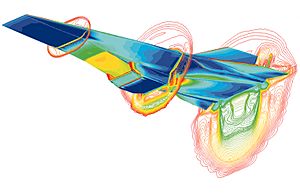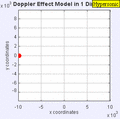Hypersonic facts for kids
Hypersonic speeds are super, super fast! When something flies at hypersonic speeds, it's going at least five times faster than the speed of sound. Imagine how fast that is! This term, "hypersonic," became popular around the 1970s. When an airplane reaches these incredible speeds, everything about how it flies changes a lot.
Contents
What are Hypersonic Speeds?
In the world of aerodynamics, "hypersonic" means speeds that are much, much faster than the speed of sound. Scientists usually agree that hypersonic speeds start at about Mach 5. This means you are traveling five times faster than sound! When an object moves this fast, the air around it behaves very differently.
How Air Behaves at Hypersonic Speeds
Even though scientists still discuss the exact definition of hypersonic speeds, they have found some special things that happen to the air when objects fly this fast. These things are very important to understand when designing super-fast aircraft.
Air Squeeze: Thin Shock Waves
When an airplane flies very fast, it creates a shock wave in front of it. Think of it like a bow wave in water, but in the air. As the plane goes faster and faster (higher Mach numbers), the air behind this shock wave gets much denser, meaning it's squeezed together more. Because of this, the space between the plane and the shock wave, called the "shock layer," becomes very thin. It's like the air gets squished into a very narrow space!
Air Mixing: Entropy Layers
When an object moves at hypersonic speeds, the air passing through the shock wave changes a lot. This change creates something called an "entropy gradient." This means the air becomes very swirly and mixes strongly with the air right next to the plane's surface. This mixing is important for how the plane flies and how much heat it experiences.
Air Friction: Viscous Heating
When air flows very fast over an object, the viscosity (or "stickiness") of the air causes a lot of kinetic energy to turn into internal energy. This makes the air's temperature go way up! Because of this temperature increase, the air near the surface of the plane becomes less dense. This causes the layer of air that sticks to the plane, called the "boundary layer," to grow thicker. This growth also makes the temperature go up even more, which is a big challenge for engineers designing hypersonic vehicles.
Images for kids
See also
 In Spanish: Velocidad hipersónica para niños
In Spanish: Velocidad hipersónica para niños



